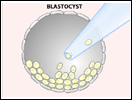Stem Cell Animations
What is a Stem Cell?
-
What is a Stem Cell? by University of Utah
How Embryonic Stem Cell Lines are Made?
- Animation by DNA Learning Center
What are Some Different Types of Stem Cells?
Find out how the body uses stem cells to grow and develop.
- What are Some Different Types of Stem Cells? by University of Utah
Human Development and Stem Cells
Human embryonic development depends on stem cells. During the course of development, cells divide, migrate, and specialize. Early in development, a group of cells called the inner cell mass (ICM) forms. These cells are able to produce all the tissues of the body. Later in development, during gastrulation, the three germ layers form, and most cells become more restricted in the types of cells that they can produce.
-
Human Development and Stem Cells (Howard Hughes Medical Institute)
Mapping Cell Fates
As a human embryo develops, its cells become progressively restricted in the types of specialized cells that they can produce. Inner cell mass (ICM) cells of the blastocyst can make any type of body cell. Gastrula-stage cells can give rise to the cells of a given germ layer. Later, cells become even more restricted. For example, the pancreatic bud of the endoderm layer can only make the cells of the pancreas.
-
Mapping Cell Fates (Howard Hughes Medical Institute)
Creating Embryonic Stem Cell Lines
The inner cell mass (ICM) cells of blastocyst-stage early human embryos can be removed and cultured. These cells can be grown in the lab indefinitely. Various growth factors cause these cells to develop into a variety of differentiated cells, such as muscle or nerve cells.
-
Creating Embryonic Stem Cell Lines (Howard Hughes Medical Institute)
Cytoplasmic Factors
Cytoplasmic factors play a significant part in determining how a cell develops. This segment discusses their importance in turning the appropriate genes on and off for proper development.
-
Cytoplasmic Factors (Howard Hughes Medical Institute)
Somatic Cell Nuclear Transfer Animation
Somatic cell nuclear transfer (SCNT) is a technique for cloning. The nucleus is removed from a healthy egg. This egg becomes the host for a nucleus that is transplanted from another cell, such as a skin cell. The resulting embryo can be used to generate embryonic stem cells with a genetic match to the nucleus donor (therapeutic cloning), or can be implanted into a surrogate mother to create a cloned individual, such as Dolly the sheep (reproductive cloning).
Zebrafish Heart Regeneration
The zebrafish heart is similar to the human heart in many respects. But unlike the human heart, the fish heart closes wounds rapidly and then regenerates to nearly full function. Fibroblast growth factor (FGF) is an important molecule in the regeneration process.
-
Zebrafish Heart Regeneration (Howard Hughes Medical Institute)
Newt Limb Regeneration
Urodele amphibians—newts and salamanders—are able to regenerate fully functional limbs in response to amputation. Cells in and near the limb stump dedifferentiate to form a mass of stemlike cells that can produce all the specialized tissues of the limb, such as muscle, nerves, and blood vessels.
-
Newt Limb Regeneration (Howard Hughes Medical Institute)
Stem Cell Therapies Today
An exploration of current and future therapies. Also featured on the recently released HHMI DVD, Potent Biology: Stem Cells, Cloning, and Regeneration, available free from HHMI. Order DVDs here.
Pkd1 expression in the mouse embryo
Stem Cells: Animations (Howard Hughes Medical Institute)
From the 2006 Holiday Lectures — Potent Biology: Stem Cells, Cloning, and Regeneration
|
SUBJECT:
General Science TITLE: What are Stem Cells? FORMAT: Macromedia Flash |
 |
|
SUBJECT:
General Science TITLE: Human Embryonic Stem Cells (extended) Includes discussion of somatic cell nuclear transfer (SCNT) FORMAT: Macromedia Flash |
 |
|
SUBJECT:
General Science TITLE: Potential Use of Human Embryonic Stem Cells to Treat Disease Includes discussion of using ES cells to treat type II diabetes FORMAT: Macromedia Flash |
 |
